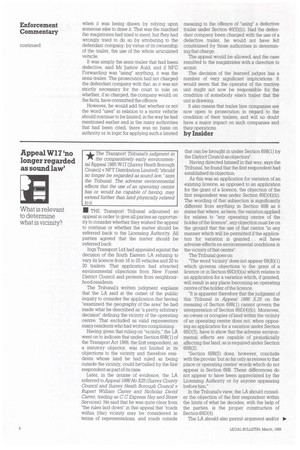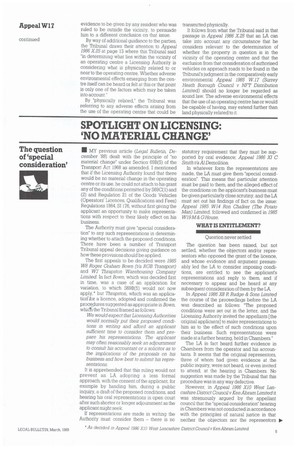Appeal W17 'no longer regarded as sound law' What is relevant to determine what is vicinity?
Page 122

Page 123

If you've noticed an error in this article please click here to report it so we can fix it.
4,, The Transport Tribunal's judgment in " the comparatively early environmental Appeal 1985 W17 (Surrey Heath Borough Council v NFT Distribution Limited) "should no longer be regarded as sound law" says the 7'nbunal The adverse environmental effects that the use of an operating centre has or would be capable of having, may extend further than land physically related to it.
• THE Transport Tribunal adjourned an appeal in order to give all parties an opportunity to consider whether they wished the appeal to continue or whether the matter should be referred back to the Licensing Authority. All parties agreed that the matter should be referred back.
Ings Transport Ltd had appealed against the decision of the South Eastern LA refusing to vary its licence from 16 to 25 vehicles and 20 to 30 trailers. That application had attracted environmental objections from New Forest District Council and protests from neighbourhood residents.
The Tribunal's written judgment explains that the LA said at the outset of the public inquiry to consider the application that having "examined the geography of the area" he had made what he described as "a pretty arbitrary decision" defining the vicinity of the operating centre. That excluded as valid representors many residents who had written complaining.
Having given that ruling on "vicinity," the LA went on to indicate that under Section 69B(1) of the Transport Act 1968, the first respondent, as a statutory objector, was not limited in its objections to the vicinity and therefore residents whose land he had ruled as being outside the vicinity, could be-called by the first respondent as part of its case.
Later, in the course of evidence, the LA referred to Appeal 1986 No X25 (Surrey County Council and Surrey Heath Borough Council v Rupert William Carter and Nicholas David Carter, trading as C C Express Hay and Straw Services). He said that he was quite clear from "the rules laid down" in that appeal that "roads within (the) vicinity may be considered in terms of representations, and roads outside that can be brought in under Section 69B(1) by the District Council as objectors".
Having directed himself in that way, says the Tribunal, he found that the first respondent had established its objection.
As this was an application for variation of an existing licence, as opposed to an application for the grant of a licence, the objection of the first respondent was under Section 69D(4)(b). The wording of that subjection is significantly different from anything in Section 69B as it states that where, as here, the variation applied for relates to 'any operating centre of the holder of the licence", any objection must be on the ground that the use of that centre "in any manner which will be permitted if the application for variation is granted. . . will have adverse effects on environmental conditions in the vicinity of that centre".
The Tribunal goes on: "The word 'vicinity' does not appear 69(B)(1) which governs objections to the grant of a licence or in Section 69D(4)(a) which relates to an application for a variation which, if granted, will result in any place becoming an operating centre of the holder of the licence.
"It is apparent therefore that the judgment of this Tribunal in Appeal 1986 X25 on the meaning of Section 69B(1) cannot govern the interpretation of Section 69D(4)(b). Moreover, an owner or occupier of land within the vicinity of an operating centre does not, when opposing an application for a variation under Section 69D(5), have to show that the adverse environmental effects are capable of prejudicially affecting that land, as is required under Section 69B(2).
"Section 69B(5) does, however, conclude with the proviso 'but so far only as relates to that place or operating centre' words which do not appear in Section 69B. These differences do not appear to have been appreciated by the Licensing Authority or by anyone appearing before him."
In the Tribunal's view, the LA should consider the objection of the first respondent within the limits of what he decides, with the help of the parties, is the proper construction of Section 69D(4).
The LA should also permit argument and/or ■ evidence to be given by any resident who was ruled to be outside the vicinity, to persuade him to a different conclusion on that issue.
By way of additional guidance to the parties, the Tribunal draws their attention to Appeal 1986 X25 at page 13 where this Tribunal said "in determining what lies within the vicinity of an operating centre a Licensing Authority is considering what is physically related to or near to the operating centre. Whether adverse environmental effects emerging from the centre itself can be heard or felt at this or that point is only one of the factors which may be taken into account."
By "physically related," the Tribunal was referring to any adverse effects arising from the use of the operating centre that could be transmitted physically.
It follows from what the Tribunal said in that passage in Appeal 1986 X25 that an LA can take into account any circumstance that he considers relevant to the determination of whether the property in question is in the vicinity of the operating centre and that the exclusion from that consideration of authorised vehicles on approach roads to be found in the Tribunal's judgment in the comparatively early environmental Appeal 1985 W. 17 (Surrey Heath Borough Council v NFT Distribution Limited) should no longer be regarded as sound law. The adverse environmental effects that the use of an operating centre has or would be capable of having, may extend further than land physically related to it.
































































































































